Gigabyte AORUS X7 DT v6 GTX 1080 Gaming Laptop Review
John Williamson / 7 years ago
Introduction
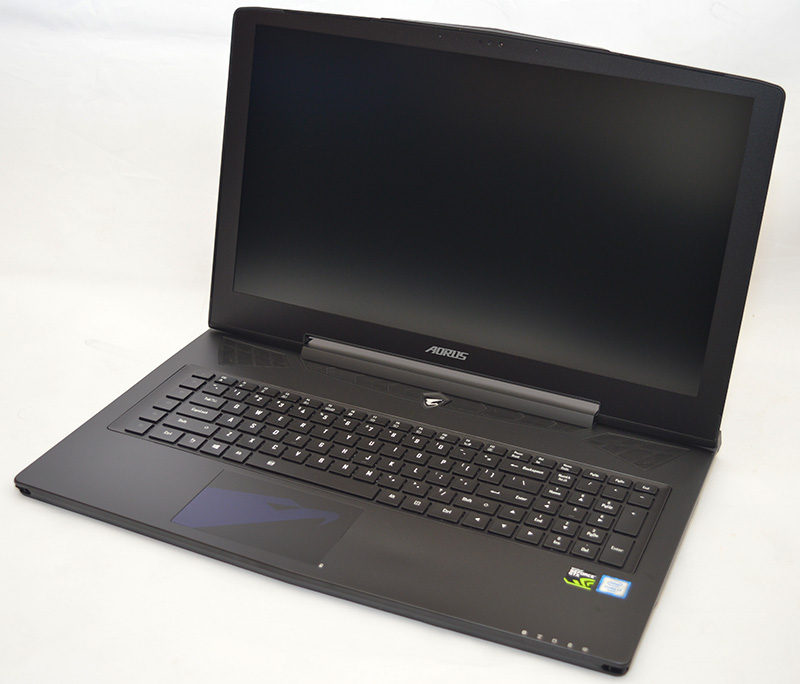
Gigabyte’s AORUS brand is reserved for gaming-orientated products which offer a premium experience without any compromises. This division is going to become a crucial part of the company’s future plans and designed to take on similar initiatives from other brands like ASUS’ ROG series. Honestly, the AORUS name wasn’t integrated into Gigabyte’s line-up particularly well and needed to be deployed in every department including motherboards, laptops, graphics cards and much more. Thankfully, it appears this strategy is beginning to take shape and I’m looking forward to seeing how the AORUS range develops over time.
Evidently, gaming laptops have been a major part of AORUS’ history and the previous models set a wonderful foundation. Recently, Gigabyte refreshed the X7 DT and made a number of important refinements. The latest flagship now utilises NVIDIA’s Pascal architecture in the form of the GTX 1080. Unlike the previous generation, the mobile versions stack up rather nicely against their desktop counterparts. As a result, gaming laptops are now a proper alternative which can easily contend with the latest games.
On another note, the AORUS X7 DT v6 is powered by an Intel Core i7-6820HK and supports overclocking up to 4.0GHz. Not only that, the laptop has 32GB DDR4 2400MHz RAM, a 17-inch 2560×1440 120Hz WVA G-Sync display, impressive audio system and a Samsung SM951 NVMe boot drive. The unit weighs a respectable 3.2KG and comes with a large battery rated to 94.24Wh. Also, the laptop has USB 3.1 Type-C connectivity, an RGB backlit keyboard and maintains a gorgeous slim profile despite the exceptional horsepower on offer. Priced at £2999, the AORUS X7 DT v6 is an expensive proposition and engineered to be the ultimate desktop replacement.
Specifications
- Name: Gigabyte AORUS X7 DT v6
- Processor: Intel Core i7-6820HK overclocked to 4.0GHz
- System Memory: 32GB (16GBx2) G.Skill Ripjaws DDR4 2400MHz Dual-Channel SO-DIMM
- Main Boot Drive: 512GB Samsung SM951 NVMe M.2 SSD
- Additional Storage Drive(s): 1TB HGST Travelstar 2.5″7K1000 7200RPM
- Graphics card: NVIDIA GeForce GTX 1080 8GB GDDR5X
- Dimensions: 428mm x 305mm x 22.9mm – 25.4mm (WxDxH)
- Weight: 3.2KG with Battery
- Display: 17.3-inch QHD 2560×1440 WVA 120Hz G-Sync
- Optical Drive: N/A
- Wireless: Killer Wireless-AC 1535 (802.11ac)
- Battery: Li-Polymer 94.24Wh
- Speakers: Dual 2-Watt Speakers and Dual 2-Watt Subwoofer
- OS: Windows 10 Home 64-Bit
- Warranty: 2-Years
- Price: £2999
Packing and Accessories
The laptop is neatly stored in a durable box which reduces the likelihood of any damage occurring during transit. Also, the box has an elegant, simplistic design which looks professional and exemplifies the product’s premium qualities.
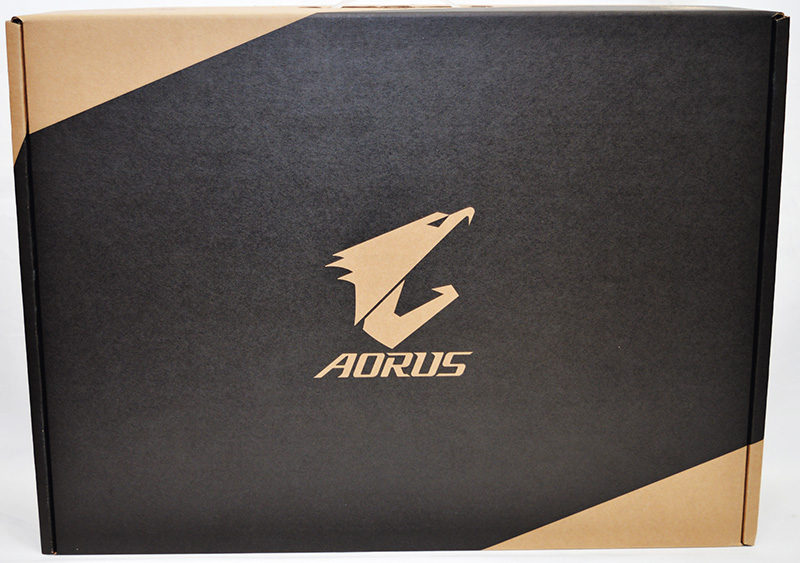
Once opened, we can see the laptop is contained within another strong cardboard box which proudly displays the AORUS logo. Additionally, the hardened box is cushioned by four foam pieces and shouldn’t rattle around while being transported. Throughout the unpackaging process, the presentation is sublime and reinforces the idea of the laptop being a luxurious item.
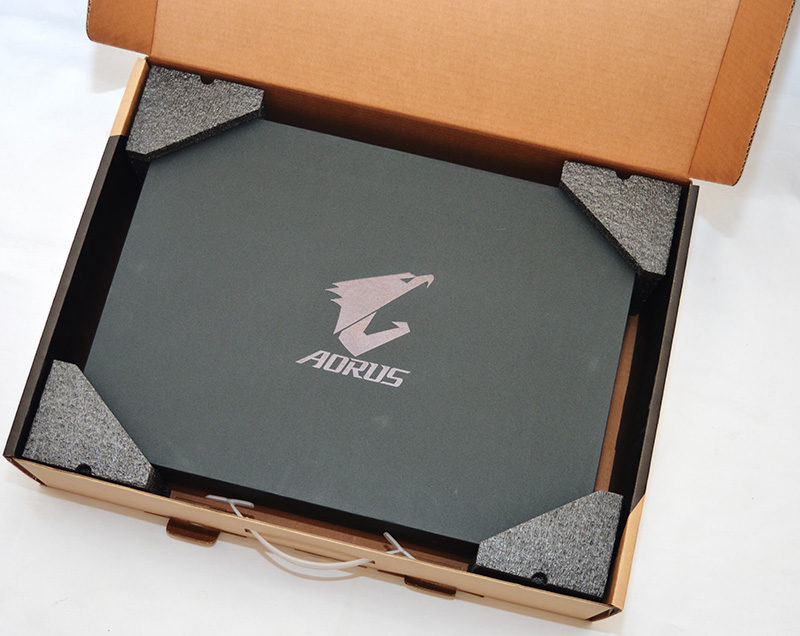
Rather impressively, the lid is filled with a luscious, soft foam and gently brushes against the laptop’s protective cover. The accessories and documentation are held within different segments underneath the system. This logical arrangement is fantastic and showcases the company’s attentive approach to making the end-user feel a sense of pride about their new purchase.
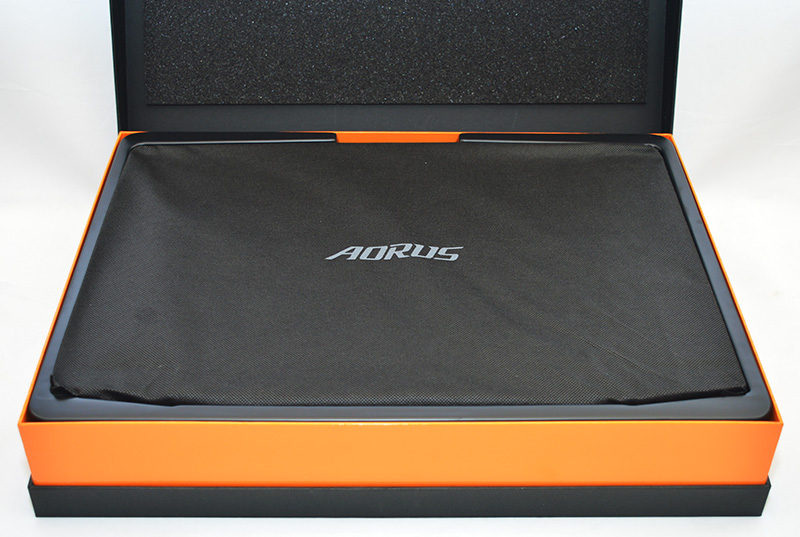
In terms of accessories, the laptop is bundled with a power adapter, UK cord, recovery USB drive, additional feet, NVIDIA GTX badge, quick user’s guide and warranty information card. The power brick isn’t particularly compact but this is to be expected when you consider the laptop’s powerful configuration. The optional feet are handy to improve the laptop’s resistance against friction, although it’s not really necessary. Also, I’m pleased to see AORUS took my previous advice on board and made sure the drivers/utilities are stored on a USB stick instead of a DVD which consumers cannot use without another PC.
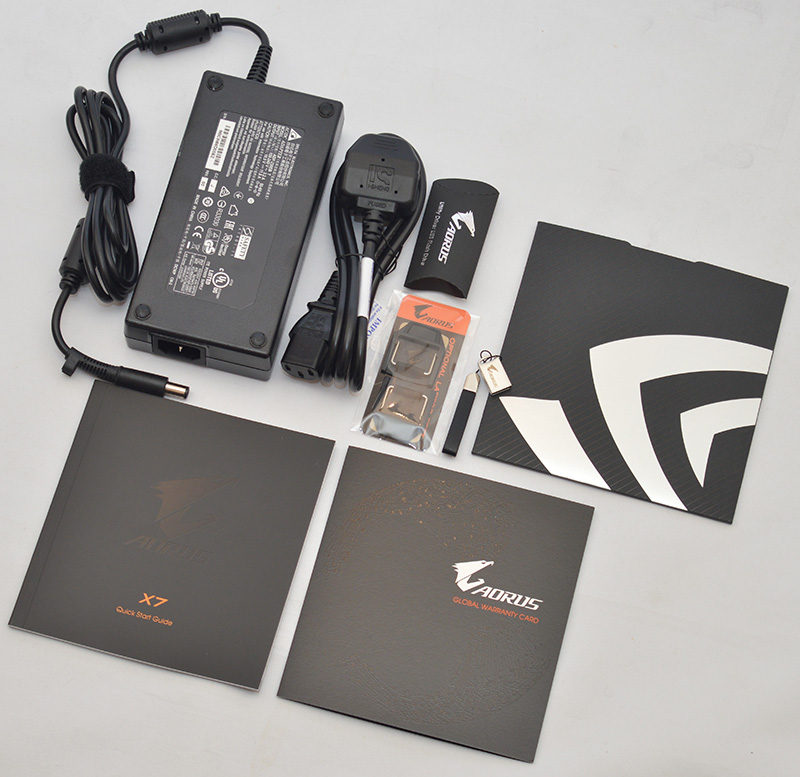
The power brick has an input rating of 100-240V at 3.A, 50-60Hz and the output is 19.5V, 11.8A. As you can see, it’s manufactured by Delta Electronics INC and passes all the relevant safety standards.
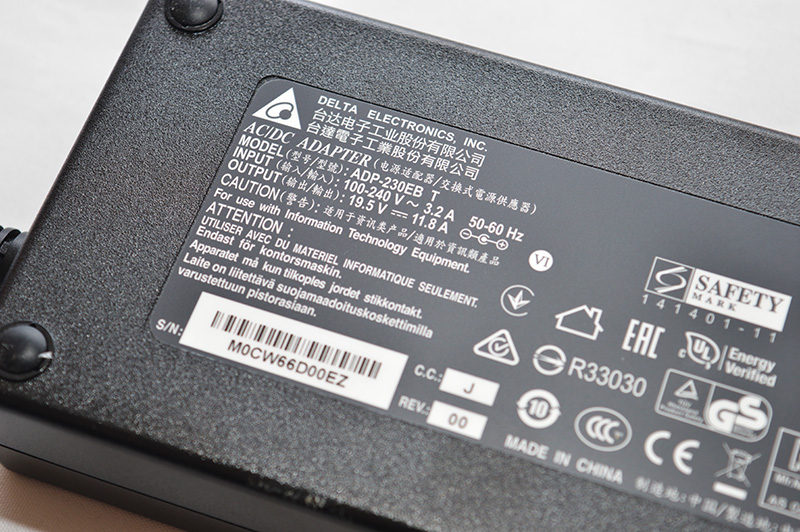
CPU-Z
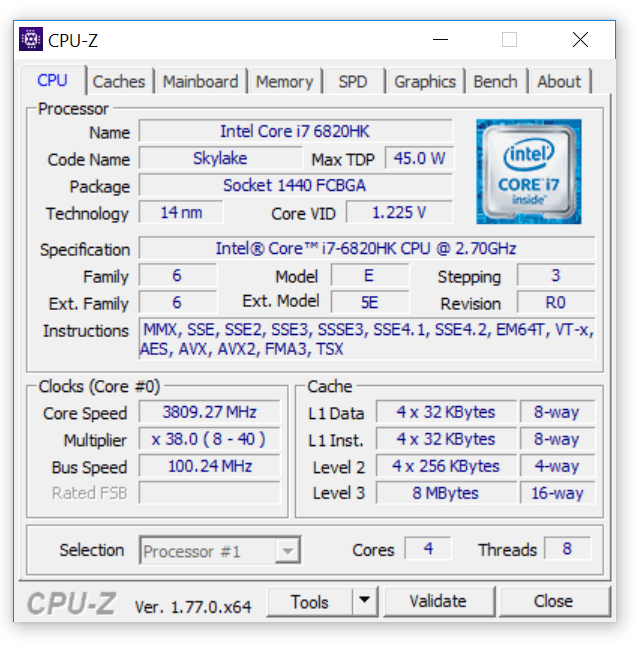
GPU-Z
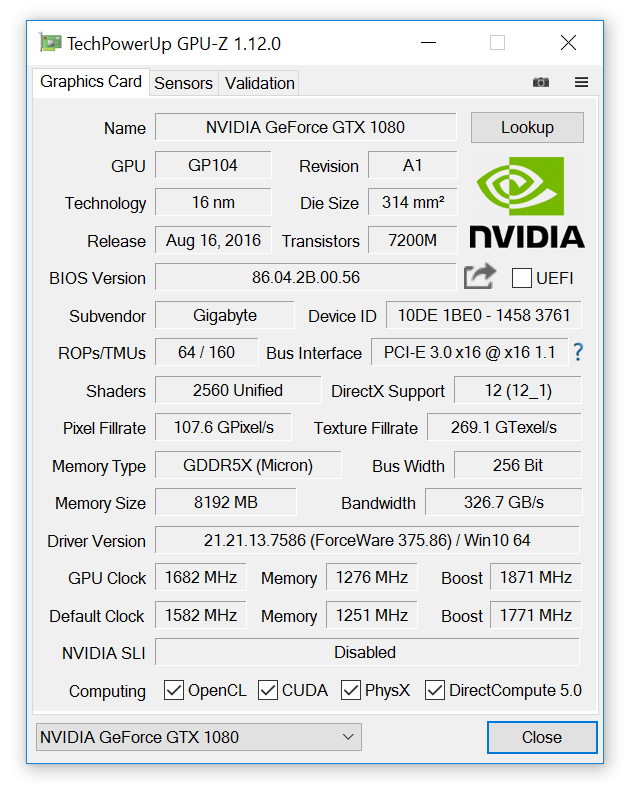
A Closer Look
The AORUS X7 DT v6 has a matte charcoal finish which looks absolutely breathtaking from every conceivable angle. Also, the smooth coating resists fingerprints remarkably well which helps to maintain a gorgeous aesthetic. The product’s styling is reminiscent of a military-grade aircraft and I instantly fell in love with the sleek design.
On another note, the AORUS logo is rather striking and injects a hint of colour into the neutral theme. The laptop’s aluminium construction and remarkably thin frame combine to offer a premium user experience. AORUS even went to the trouble of moulding a dedicated section which makes it easier to open the lid. More specifically, the shape surrounds your hand in a natural way and provides a strong piece to hold on to.
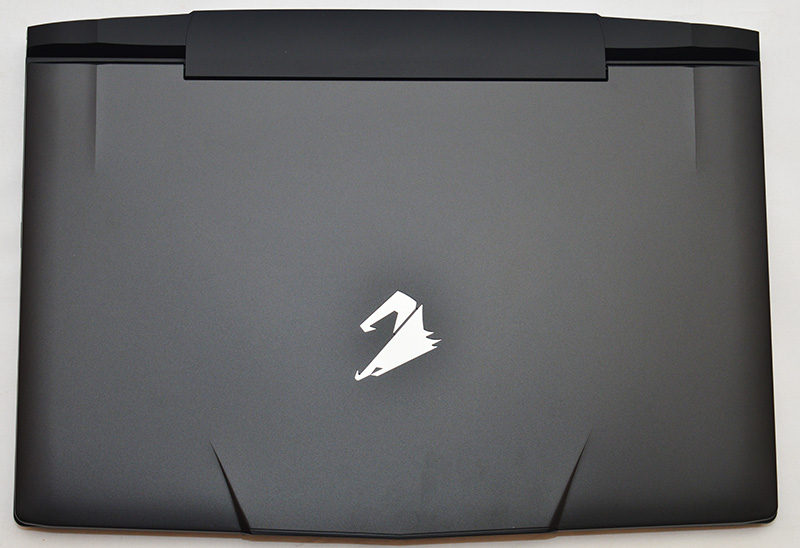
The laptop utilises a copious supply of durable rubber feet which proficiently holds the unit in position and prevents sliding. These are secured with a strong adhesive and shouldn’t come loose over time. Throughout the review process, the laptop doesn’t move in an abrupt way even when undue forced was applied. The bottom portion also houses various ventilation grilles which aid heat dissipation. The ventilation is rather impressive and spanned across a large surface area. This should maximise airflow and lead to better thermal results. AORUS embedded two grilles underneath the speakers as a way of enhancing the audio clarity.
Dismantling the product is a surprisingly simple task providing you have the correct tools. All you have to do is remove 12 Torx screws and gently lift the cover off. Unlike many laptops on the market, the cover can be pried away without a plastic tool and doesn’t require a lot of force. Perhaps, this is due to the reliance on screws instead of additional sticky strips. Please note, the screws are not the same size and it’s vital to write down where each screw should be installed. Furthermore, two of the screws have a security residue which needs to be scraped away. In an ideal world, I would have preferred and easy access flap to upgrade the memory, but this wasn’t possible due to the sealed, aluminium housing. While Torx screws are annoying, it’s a sensible precaution to discourage the end-user from opening a laptop worth so much money.
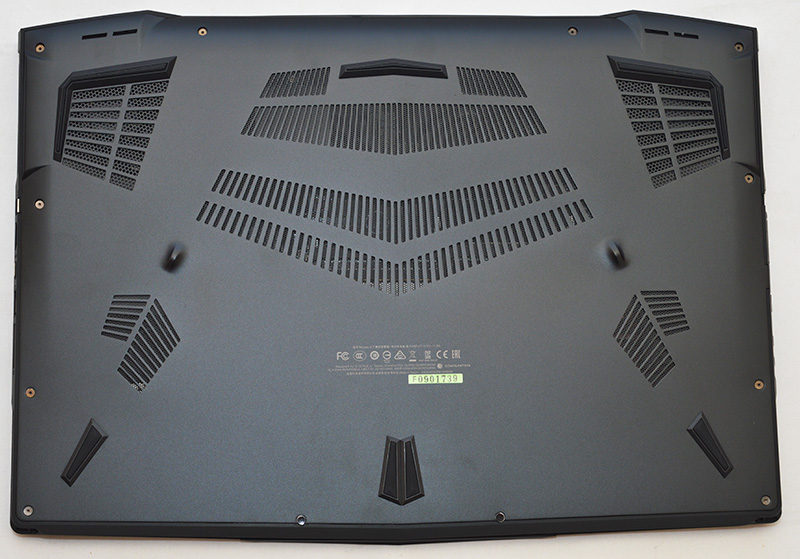
Once the bottom cover has taken off, we can see the screw points, supporting tape and ventilation arrangement. The cover is made to a high standard and doesn’t flex too much.
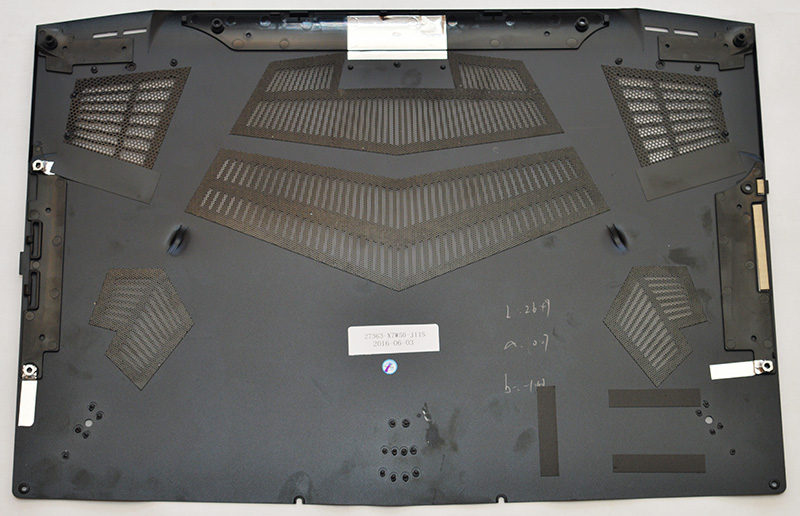
The laptop’s layout is exemplary and every millimetre of space has been used to maximise the unit’s cooling prowess. Of course, the thin frame restricts the kind of cooling hardware which can be installed. Despite the lack of room, AORUS managed to incorporate two relatively large fans which connect to a complex heat pipe system. These thick heat pipes dynamically cool the CPU and GPU while the air intakes work to improve the circulation around the internal components. On another note, a significant portion of the build has been reserved for the battery which has a rating of 94.24Wh.
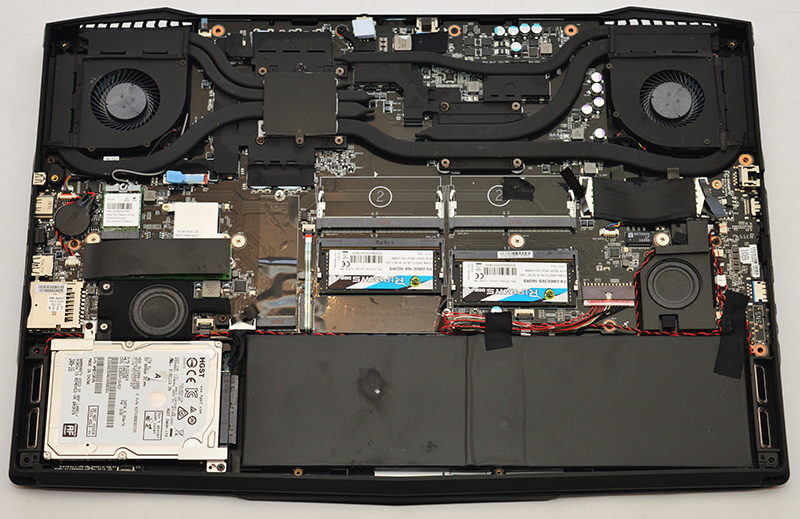
Upon closer inspection, you tend to have a greater appreciate of the heat pipes’ mammoth thickness and the excellent PCB design.
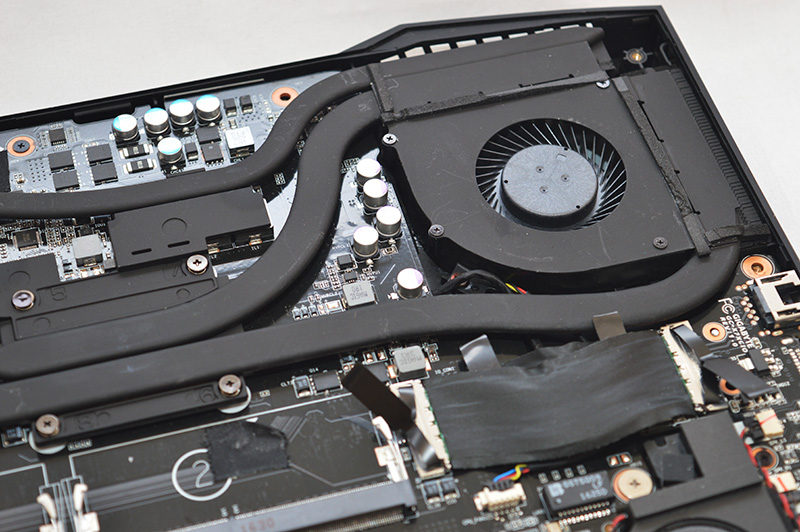
Rather impressively, the laptop has two high-end 16GB SO-DIMMS from G.Skill running at a 2400MHz frequency. Not only that, you can install another two modules to achieve a memory capacity up to 64GB. This provides the end-user with a superb upgrade path to help the machine contend with extreme RAM-heavy workloads. The slots’ central position is easy to access and doesn’t require any cables to be removed.
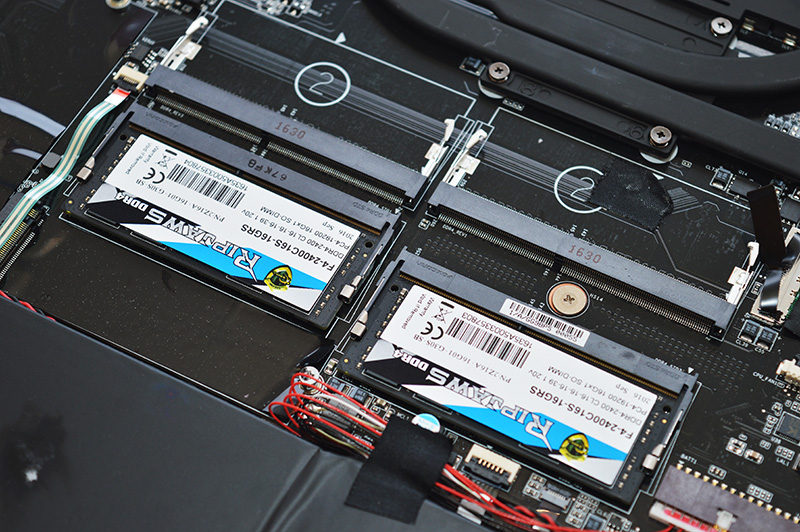
By default, the Samsung SM951 NVMe drive is shielded by a ribbon cover. Perhaps, this is to help insulate the drive from other heat sources and prevent thermal throttling. Whatever the reason, it’s a nice touch and showcases AORUS ‘s attention-to-detail. It’s theoretically possible to install another Samsung SM951 drive and create a ridiculously fast RAID array. As you can see, the M.2 slot isn’t too challenging to access which makes storage upgrades a distinct option for the future. Next to the boot SSD is a speaker and Wireless card.
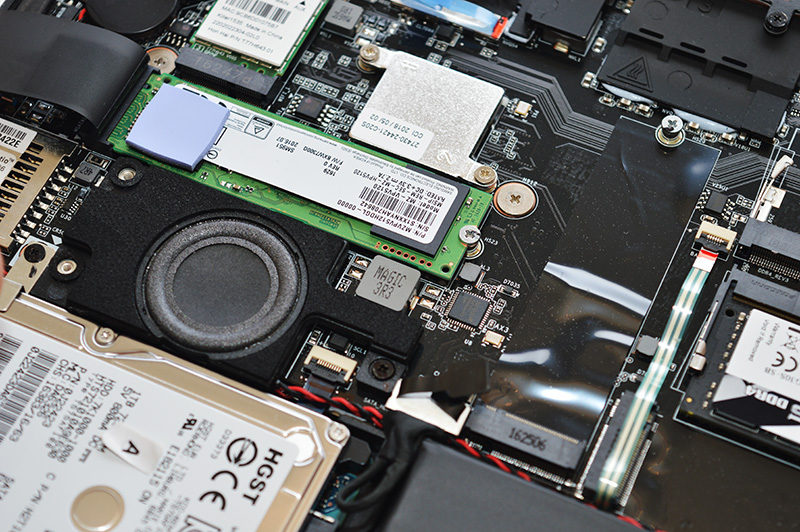
The laptop’s cable management is absolutely stellar as shown by the speaker’s wiring which connects directly to the PCB.
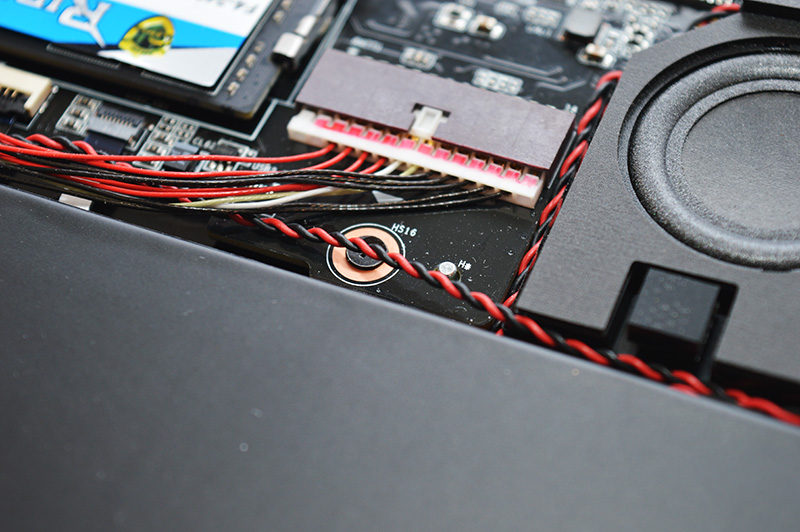
Connectivity-wise, the product has a Kensington Lock, RJ45, surround port, USB 3.0, headphone jack with S/PDIF out and microphone jack. Also, there’s an air vent and speaker out grille. Bizarrely, the laptop incorporates what appears to be a VGA port but it’s filled in by a rubber cover.
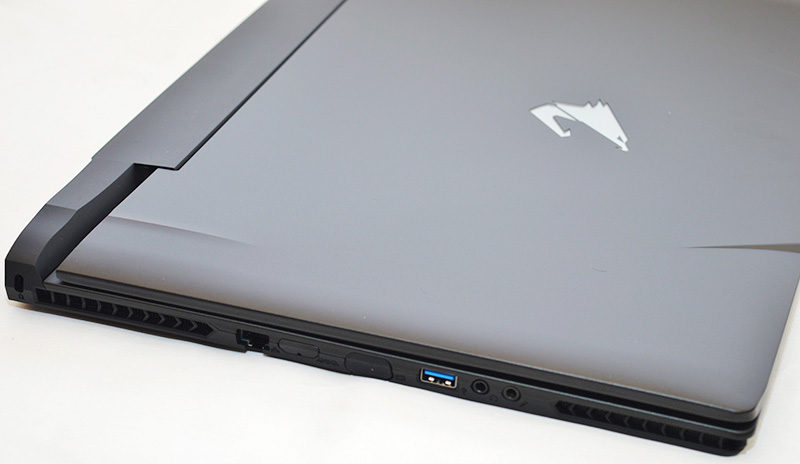
On the opposite side, AORUS included an SD card reader, USB 3.0, USB 3.1 Type-C, HDMI 2.0 capable of a 4K 60Hz output and Mini-DisplayPort. Once again, AORUS integrated two air vents to improve the thermals around the entire machine.
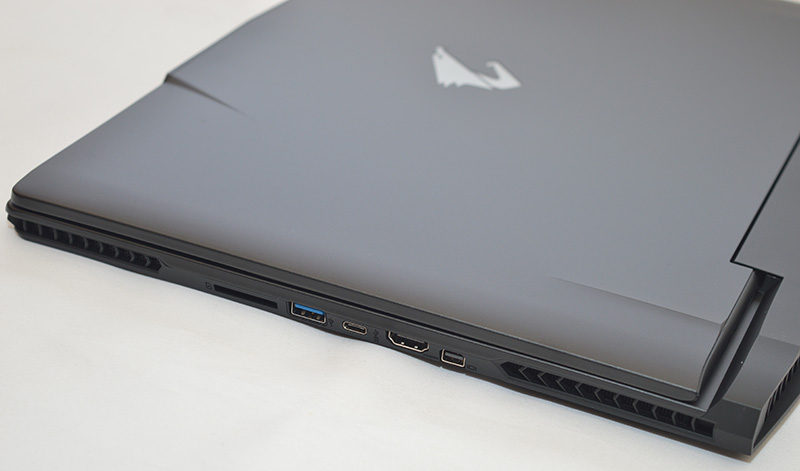
Next up is the rear section which contains two hefty ventilation grilles, a DC in jack and another USB 3.0 port. Honestly, I think the DC in’s positioning is quite clever because it’s really simple to route the cabling without it becoming tangled. If the DC in jack was integrated on either side of the chassis, you’re likely to try to attach the cable to the wrong side without looking.

The AORUS X7 DT v6 employs a 2560×1440 WVA G-Sync enabled panel supporting a 120Hz refresh rate. Furthermore, the screen has a 5ms response time and is suitable for gaming purposes. During the testing phase, the display didn’t suffer from any input lag or ghosting and outputted a warm, vivid picture. The panel’s colour accuracy is superb which accentuates background details exceedingly well. I was really impressed by the distinctiveness of different shades and the sharp, crisp text thanks to a high pixels-per-inch rate. The viewing angles were better than typical TN panels but I did detect a slight colour shift. It’s not too dramatic and the colours remain fairly consistent at most viewing positions. The 120Hz refresh rate can revolutionise the gaming experience and make Windows seem more responsive.
NVIDIA’s G-Sync technology is a revelation and completely eliminates stutter caused by V-Sync and screen tearing. When combined with the 120Hz refresh rate, the end-result is phenomenal and helps demanding games to feel smooth even if there are sudden frame rate fluctuations.
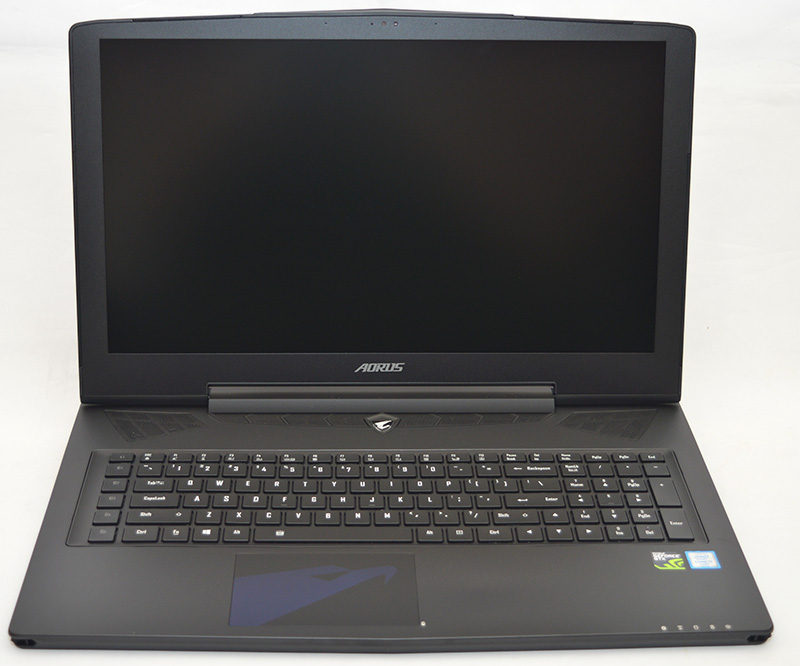
Here we can see the laptop’s lid is supported by a heavy-duty hinge which prevents screen wobble and improves the unit’s structural rigidity. As a result, the product should be able to withstand a great deal of strain while travelling.
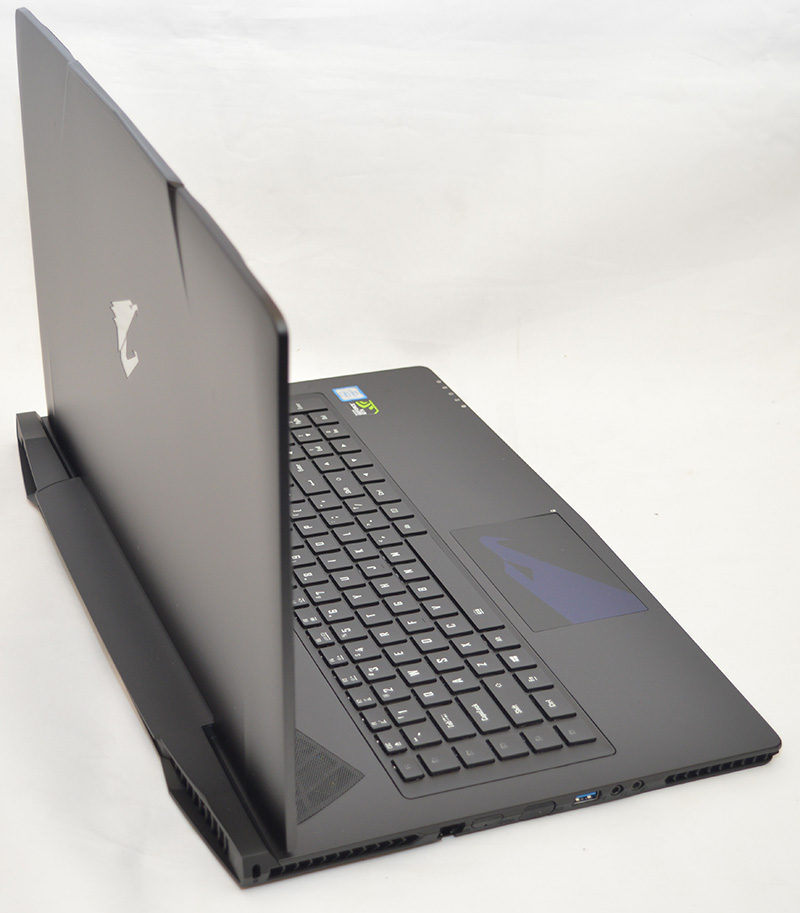
The laptop’s keyboard opts for a chiclet design which encourages you to adopt a more ergonomic typing position, resulting in fewer mistakes. The keys have a very clear, easy-to-read print which comes in handy if you’re not a touch-typist. Also, the keys have a pleasant tactile feel which requires just about the right amount of travel. As a result, you can actuate the keys without double pressing and be able to write large documents in a fluid motion. Thankfully, the macro keys are now closer to the main QWERTY layout and within finger’s reach. Previously, they required slightly too much hand movement which felt a little awkward.
In terms of audio, the laptop has two 2-watt speakers and dual 2-watt subwoofers. This is a pretty substantial solution given the laptop’s thin frame and the audio fidelity is surprisingly decent. While it’s not going to rival a set of budget speakers, the laptop has a balanced, rich sound and can output loud volumes without distortion. The sound is extremely clean, albeit a little too clinical for my liking.
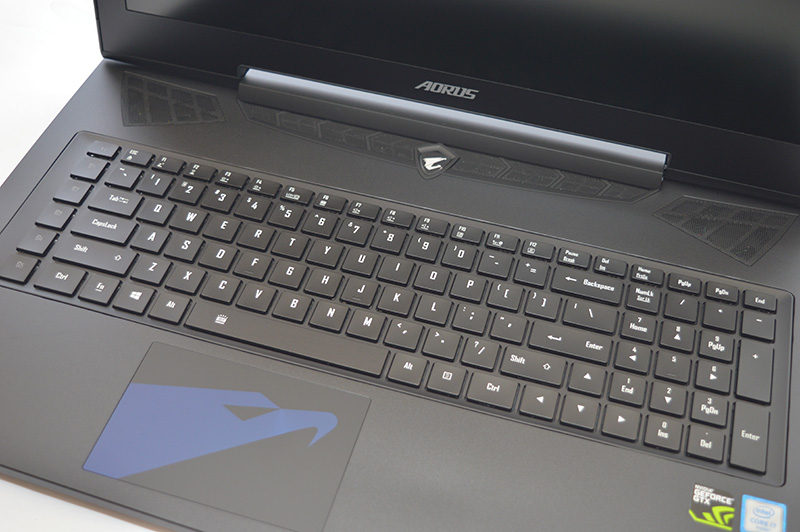
At long last, AORUS has introduced per-key RGB backlighting supporting a whopping 16.8 million colours. The individual colours look spectacular and add a sense of character to the laptop. Mostly importantly, the RGB element doesn’t suffer from any light leakage or blending between the different shades. The backlighting isn’t overpowering on the maximum setting and has an appropriate amount of luminosity to aid typing at night. It’s also possible to customise the lighting through AORUS’ software package, which I’ll come on to discuss soon.
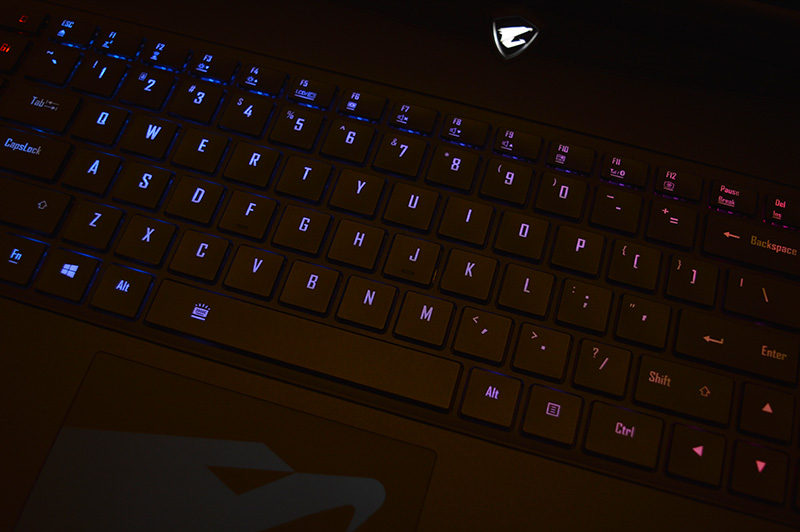
The AORUS X7 DT v6 has a brand new trackpad which is extremely responsive and a joy to use. In particular, the soft finish feels very comfortable and doesn’t exhibit any form of jittery movement. The tracking is perfectly stable and the large surface area allows you to position the cursor with a greater degree of accuracy. Also, the trackpad’s surface manages to repel grease from the user’s hands and maintain a lovely finish. The stealth buttons are passable but they tend to feel quite spongey. Not only that, if you gently glance at the mousepad’s edge, it’s unlikely for the buttons to respond in a rapid manner. To be fair, I’ve encountered much worse and the trackpad should be ample for most scenarios.
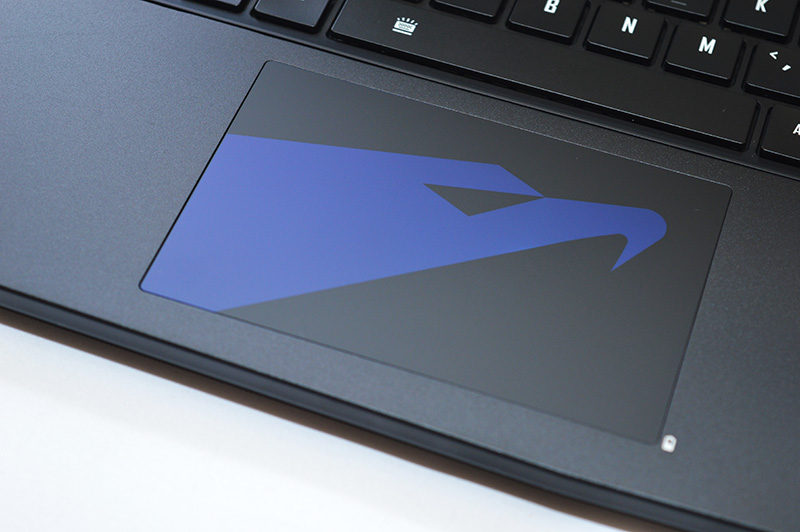
AORUS’ Command & Control utility lists a huge array of options to tweak key system characteristics. For example, you can change the fan control, mouse speed, volume, brightness levels, power mode and much more! The fan control contains different profiles which prioritise raw performance, quiet operation or a combination of both. Another great addition is the Colour Gamut which proves handy to adjust the display’s characteristics to your own personal preference. Overall, a great application which is packed full of settings and easy to use.
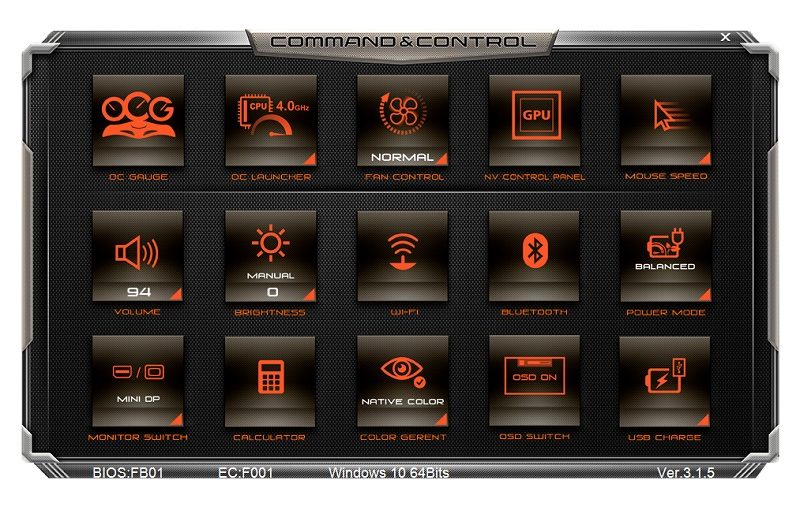
Here we can see OC Guage menu which automatically detects the laptop’s thermal loads and sets an appropriate overclock for both the GPU and CPU. If you’re unhappy with the configuration, it’s possible to select a more modest overclock to reduce the fan noise.
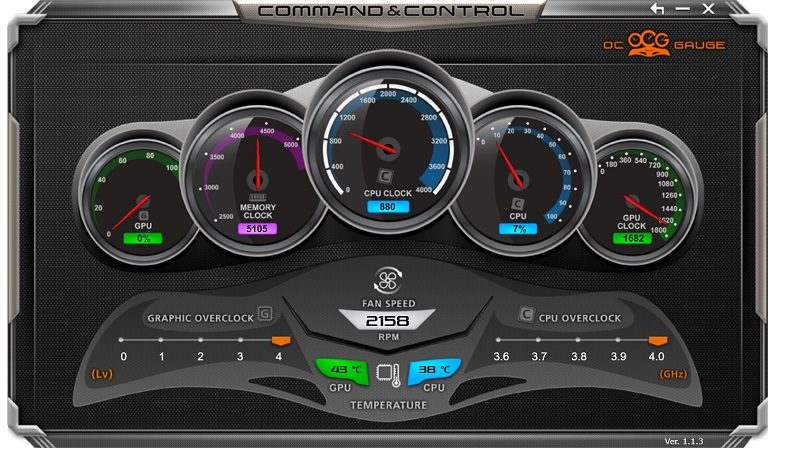
The AORUS Fusion software is handy to configure macro commands and choose from an enormous range of lighting effects including wave, marquee, neon and others shown in the image below. This level of customisation is exceptional and the software is more comprehensive than I expected. Additionally, you can change the brightness, speed and direction of each transitional effect.
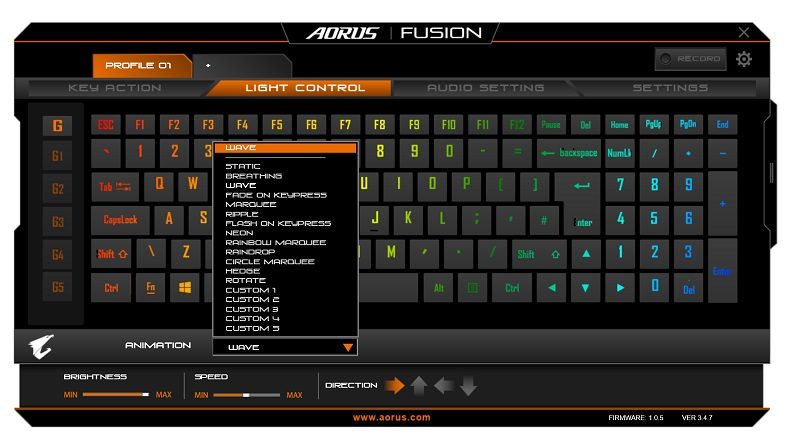
In the Audio Equalizer menu, you can select between a number of pre-defined profiles designed for contrasting situations. Honestly, I didn’t hear see a major difference apart from a slight alternation to the audio’s mix.
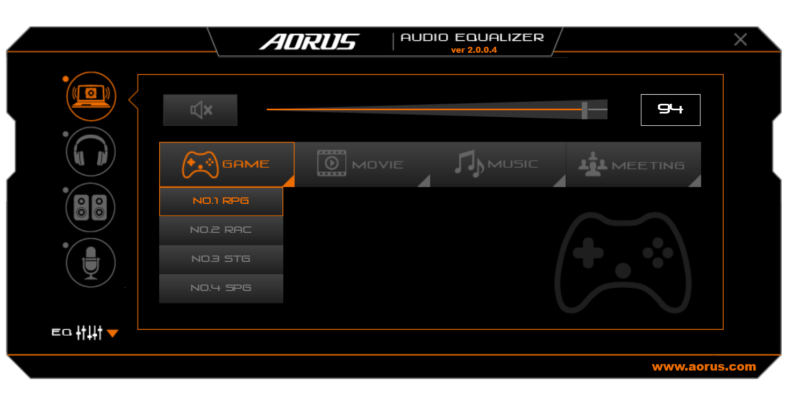
Testing & Methodology
To test each system or notebook, we want to stress every component of the system to check stability and performance, giving us an idea as to why those particular components were picked for this particular system. We use a wide variety of applications to gain a broad spectrum of results for comparing diverse aspects of system performance.
Unless specifically stated, all games are running at maximum settings but any vendor-exclusive features such as TressFX or PhsyX have been disabled to make the results fair. There are some titles where the maximum preset can be altered further in regards to AA, AF, Tessellation, and Draw Distance. To allow our readers to make the most informed decision, any additional options will be clearly labelled in this section. Please note each benchmark is run three times to maintain the highest level of accuracy.
Hardware
- Acoustic dBA meter
- AC “Killawatt” power meter
Software
- 3DMark
- AIDA64 Engineer
- Cinebench R15
- CrystalDiskMark
- CPU-Z
- GPU-Z
- HW-Monitor
- MSI Afterburner
- Passmark PerformanceTest 8.0
- PCMark 8
- Prime95
- WPrime
- Unigine Heaven 4.0
- Grand Theft Auto 5
- Rise of the Tomb Raider
- Hitman
- Far Cry Primal
PC Mark 8
The PCMark 8 Home benchmark includes workloads that reflect common tasks for a typical home user. These workloads have low computational requirements making PCMark 8 Home suitable for testing the performance of low-cost tablets, notebooks, and desktops. Home includes workloads for web browsing, writing, gaming, photo editing, and video chat. The results are combined to give a PCMark 8 Home score for your system. Download here.
3D Mark
The new 3DMark includes everything you need to benchmark your hardware. With three all new tests you can bench everything from smartphones and tablets to notebooks and home PCs, to the latest high-end, multi-GPU gaming desktops. Download here.
Grand Theft Auto V
Our GTA5 Benchmark is run on the standard benchmark with MSAA=Off, FXAA=On, Advanced Graphics Disabled and everything else set to their maximum values:

Rise of the Tomb Raider
Even though Rise of the Tomb Raider recommends graphics cards above 4GB for the Very High preset, we believe it’s the best option to stress graphics cards and distinguish between systems opting for different hardware. Of course, lower-end hardware can struggle with the benchmark and output some unusual results. FXAA is also enabled.
Hitman
To properly test DirectX 12 performance, the integrated Hitman benchmark is used and everything is set to maximum with FXAA set to on.
Far Cry Primal
In this game, the Ultra preset is selected with the HD texture pack and FXAA. Once the settings have been dialled in, the game’s built-in benchmark is run on multiple occasions before recording the average data.
Cinebench R15
Cinebench is a widely respected benchmark for testing the performance of x86 CPUs. The program allows you to test single and multi-threaded performance as well as GPU performance by rendering with Open GL. Download here.
WPrime
WPrime is a computer program that calculates a set number of square roots using Newton’s method for estimating functions verifying the results by squaring them then comparing them with the original numbers. Download
AIDA64 Engineer Edition
AIDA64 Engineer is a streamlined Windows diagnostic and benchmarking software for engineers. It has unique capabilities to assess the performance of the processor, system memory, and disk drives. AIDA64 is compatible with all current 32-bit and 64-bit Microsoft Windows operating systems, including Windows 8 and Windows Server 2012. Memory and cache benchmarks are available to analyse system RAM bandwidth and latency. Download here.
CrystalDiskMark
CrystalDiskMark is a portable storage drive benchmark utility that enables you to measure sequential and random read/write speeds on different block size data. CrystalDiskMark will work with any storage drives including hard drives, SSDs and USB flash drives. Download here.
Passmark
The PassMark Advanced Network Test (which is part of PerformanceTest) is designed to test the data transfer rate between two computers both of which must be running PerformanceTest. One of the computers must act as the server and will sit waiting for a connection. The other computer acts as a client. It connects to the server machine and sends data to it for the duration of the test. You can download a trial version of PerformanceTest from here.
Acoustic Performance
The amount of noise produced by any computer is a vital consideration for most buyers, even gamers don’t really want a noisy PC because less noise is always better. We use an acoustic dBA meter held 2 feet behind our test system at idle and under load to get the idle and load noise levels for the system. For idle we allow the system to sit at the Windows desktop, for load we let Unigine Heaven 4.0 and Prime95 to loop together – we take the acoustic measurements 5 minutes into both of these scenarios.
Battery Life
To accurately test battery life, the Powermark benchmark is run in balanced mode which emulates the typical usage scenario including web browsing, photo editing, light gaming and other basic tasks. From my experience, this is a pretty reliable tool and provides a great insight into a laptop’s battery life.
Power Consumption
To test power consumption we measure the total system power draw during idle and load scenarios. For idle we allow the system to sit at the Windows desktop, for load we let Unigine Heaven 4.0 and Prime95 to loop together – we take the power measurements from the “Killawatt” AC power meter 5 minutes into both of these scenarios at the same point.
Temperatures
To test thermal performance we measure average CPU and GPU core temperatures during idle and load scenarios. For idle we allow the system to sit at the Windows desktop, for load we let Unigine Heaven 4.0 and Prime95 to loop together – we take the temperature measurements from within CPUID HWMonitor 5 minutes into both of these scenarios at the same point. For load we take the average of the maximum temperatures, for idle we take the average of the minimum temperatures.
Synthetic Benchmarks
PC Mark 8
When tackling the PC Mark 8 benchmark, the laptop obtained a commendable score which illustrates its abilities in a wide range of common tasks including photo editing, web browsing, teleconferencing and more.
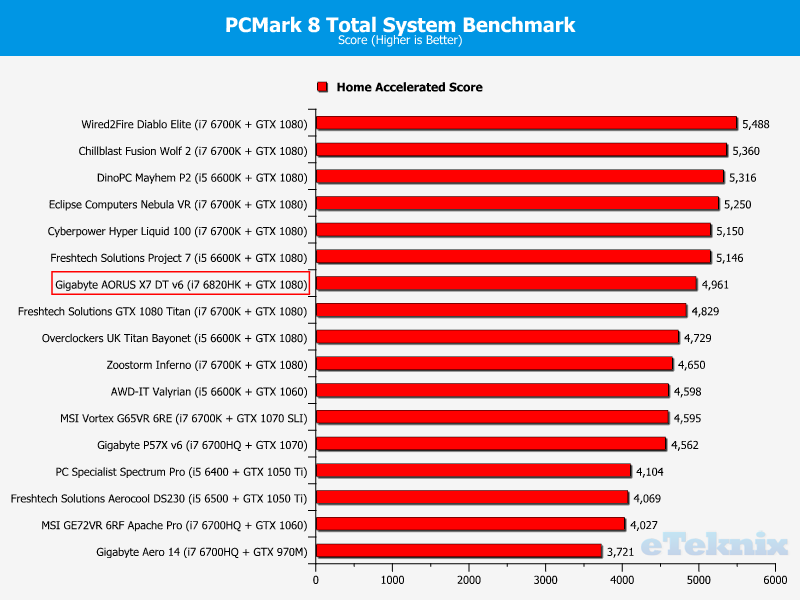
3DMark
Unbelievably, the AORUS X7 DT v6 is able to outperform two desktops which utilise a discrete version of the GTX 1080. This is a remarkable result for a laptop which outlines the monumental gains compared to the previous generation mobile chips. Of course, each system is returned after testing which means the laptop benefits from driver enhancements. Also, the i7-6820HK contributes towards the higher scores and can leverage the extra four threads in synthetic applications rather well.
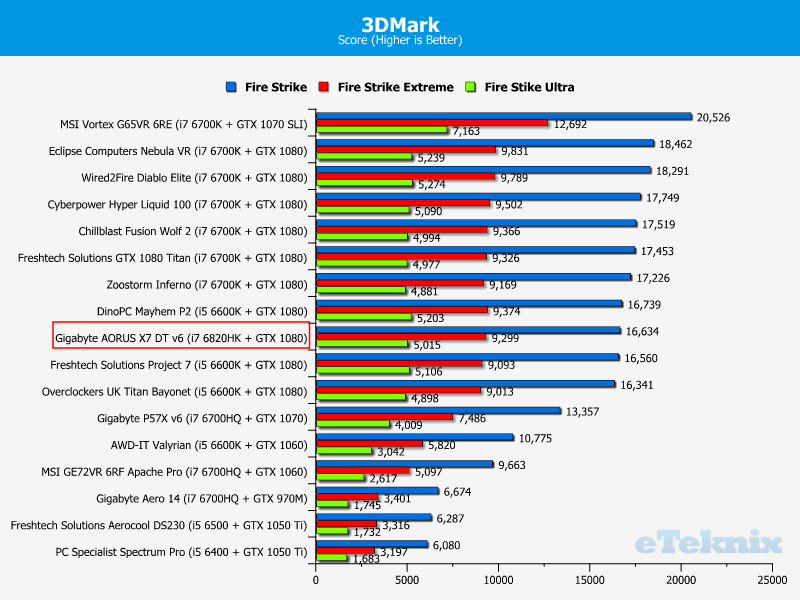
Gaming Performance
Grand Theft Auto V
Even though Grand Theft Auto V isn’t a particular new title, it’s a firm favourite among the PC gaming community and looks breathtaking. Once the panel was manually configured to 1920×1080, the frame rate remained extremely consistent and rarely dropped below the 100 mark. Interestingly, the performance deficit to other GTX 1080-based systems during 1080p testing is larger than I anticipated but it’s not enough to inhibit the user experience. After setting the resolution to 2560×1440, the frame rate barely dropped and was much more competitive. Even more impressive, the laptop can contend with the Very High preset while being connected to an external 4K monitor. This is staggering for a portable device and would have been unthinkable not so long ago.
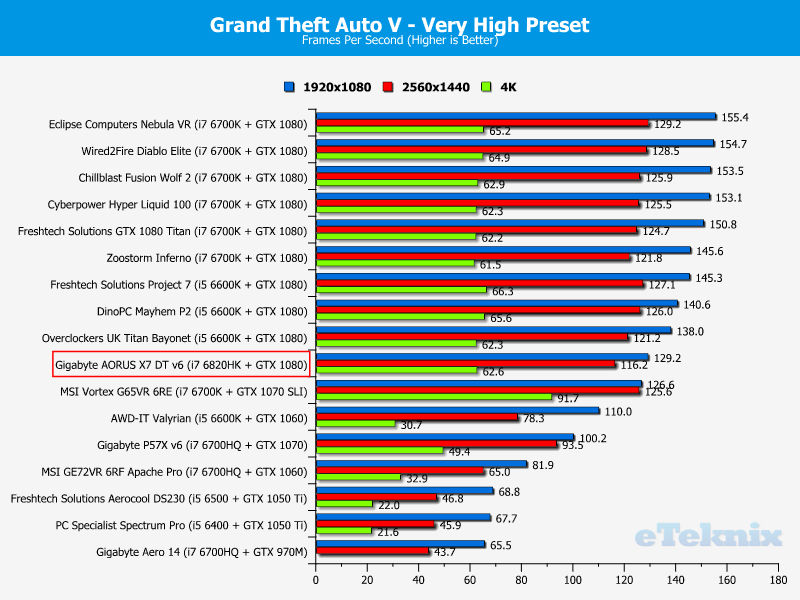
Rise of the Tomb Raider
During the Rise of the Tomb Raider benchmark, the laptop fared extraordinarily well and exceeded 120 frames per second alongside a 1080p render. This creates a perfectly fluid user experience and the frame rate doesn’t appear to dip in a noticeable manner. Additionally, the 1440p performance was superb and not too adrift of reaching the 100 frames per second mark. Also, the minimum frame rate stays above 60 throughout the most visually intense sections. When testing the game on a 4K display, the laptop maintained a stable frame rate which is fairly playable. However, like many other GTX 1080 systems, the ideal 60 figure cannot be achieved and some areas tend to result in some minor stuttering.
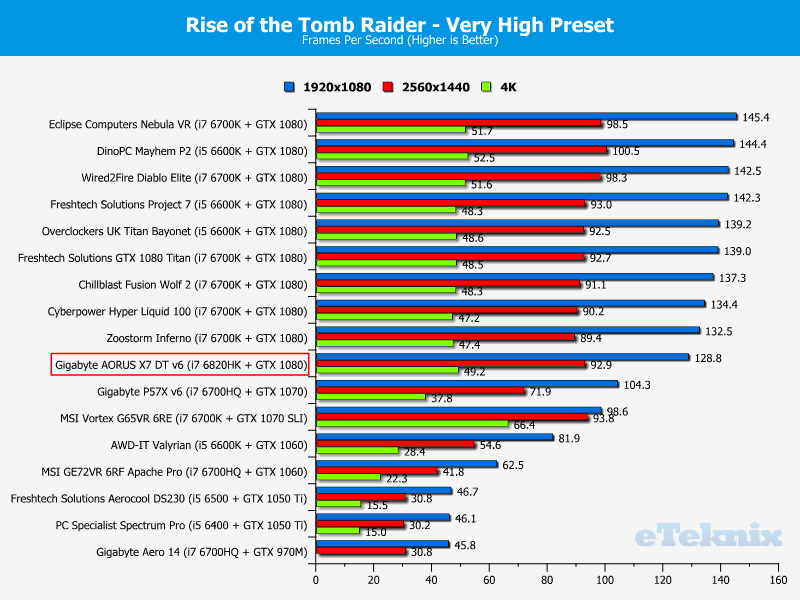
Hitman
In Hitman, the laptop’s GPU excelled and managed to surpass 100 frames per second while running the game at 1920×1080. This is another fantastic result, especially when you take into account the ultra preset’s demanding effects. Also, the laptop offers similar performance to a number of premium desktops. When using the product’s native resolution, the frame rate falls just under 90 and doesn’t deviate too much. As expected, the laptop’s frame rate drops considerably once a 4K monitor is deployed although the gameplay feels relatively fluid.
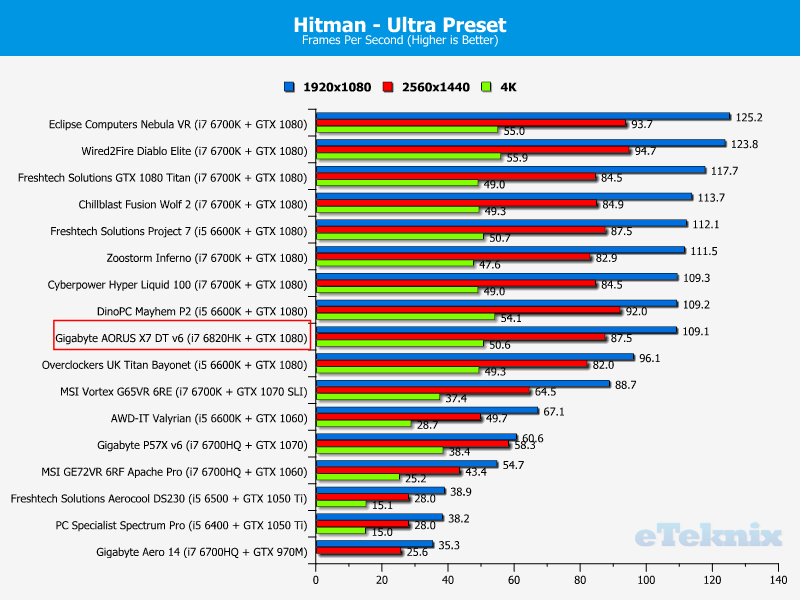
Far Cry Primal
Here we can see, the AORUS X7 DT v6 easily copes with Far Cry Primal’s ultra preset and posts marvellous performance numbers. More specifically, the 1080p frame rate is very smooth and you’re unlikely to experience any kind of erratic drops. When using the panel’s native resolution, the frame rate is above 60 by a decent margin and G-Sync really makes any frame rate changes seem non-existent. Unfortunately, the laptop’s graphics solution begins to falter when trying to run the game on a 4K monitor at maximum settings. Thankfully, a few concessions in the options menu will make 60 frames per second a distinct possibility.
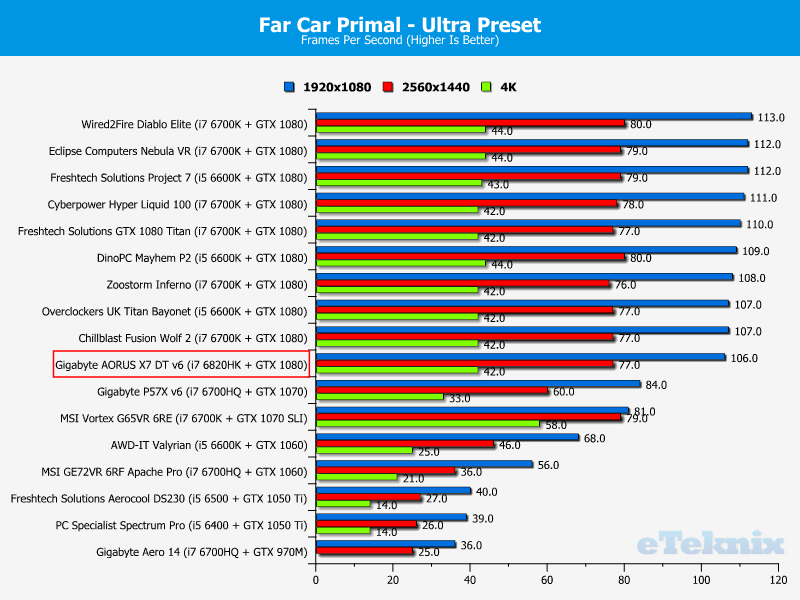
CPU & Memory Performance
Cinebench R15
The AORUS X7 DT v6 has an overclocked i7-6820HK which offers very impressive multi-threaded performance. As you can see, this processor was able to defeat an Intel i5-6600K running at a hefty 4.6GHz frequency and remained within touching distance of the higher end i7 variant.
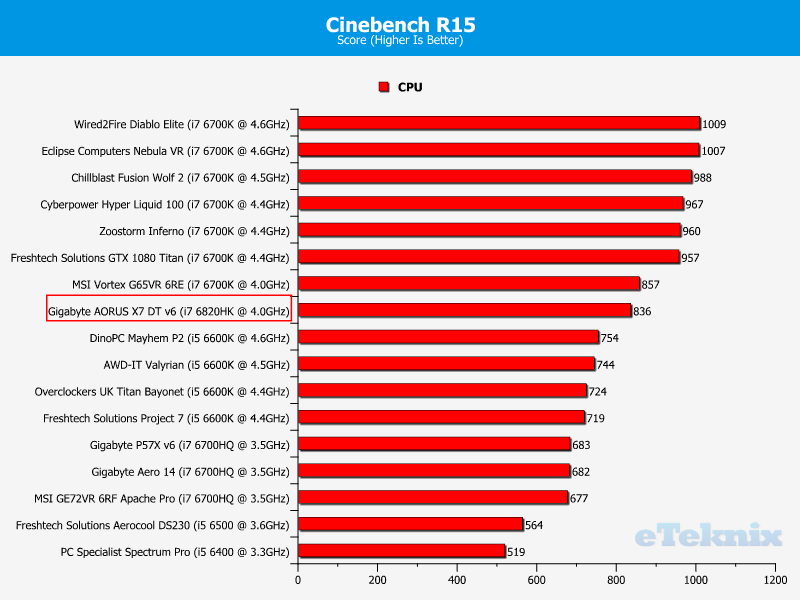
WPrime
On a similar note, the laptop’s processor completes the Pi calculation task in an extremely quick fashion and uses Intel’s hyperthreading technology to pull ahead of the i5 6600K by a good margin.
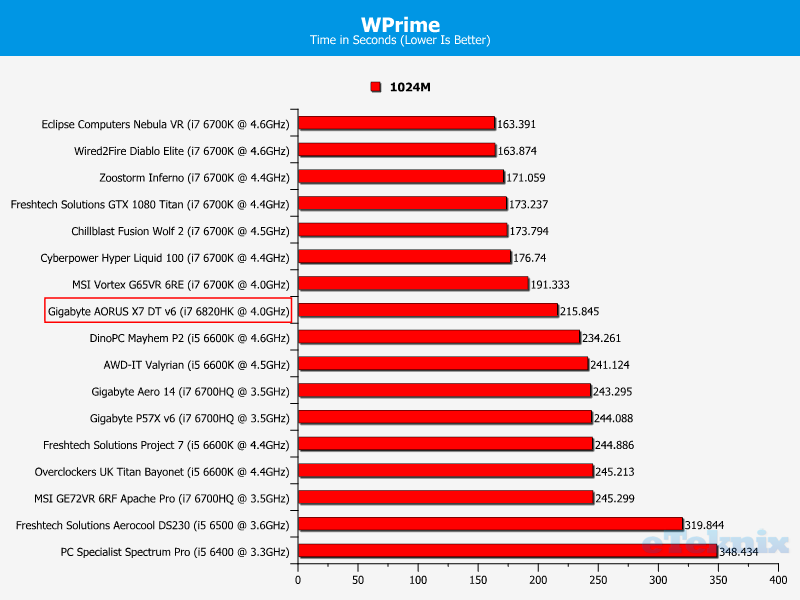
AIDA64 Engineer
The unit’s 2400MHz dual-channel memory configuration outputs commendable read, write and copy rates. Interestingly, the AORUS X7 DT v6 managed to defeat the MSI Vortex G65VR 6RE despite having a mobile processor.
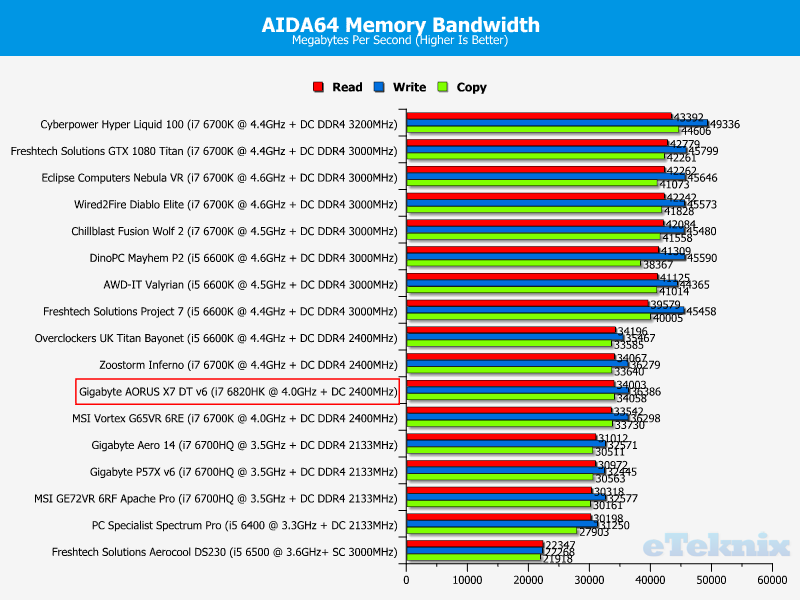
Storage and USB Performance
CrystalDiskMark – Sequential Read
The Samsung SM951 NVME boot drive is an engineering marvel and widely used in a number of premium laptops. It’s easy to see why with read a result of 2259MB/s which makes other storage solutions look quite ordinary in comparison. The laptop’s 2.5-inch secondary disk device reported an excellent read rate while the USB 3.0 was also quite strong.
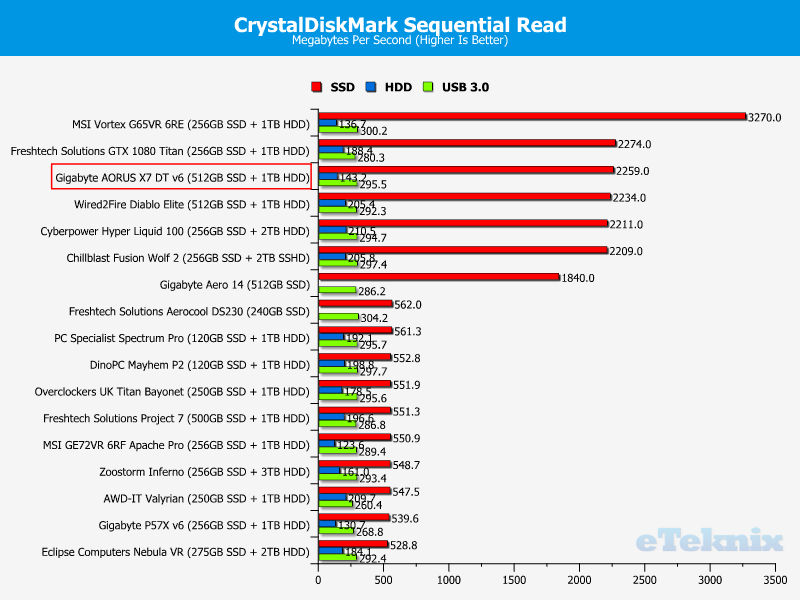
CrystalDiskMark – Sequential Write
This time, the laptop’s boot drive came out on top and almost broke the 1600MB/s mark. I’m sure you can agree, this is a ridiculously high write rate and will prove quite challenging to beat. The mechanical disk achieved decent write speeds and the USB 3.0 performance deserves praise.
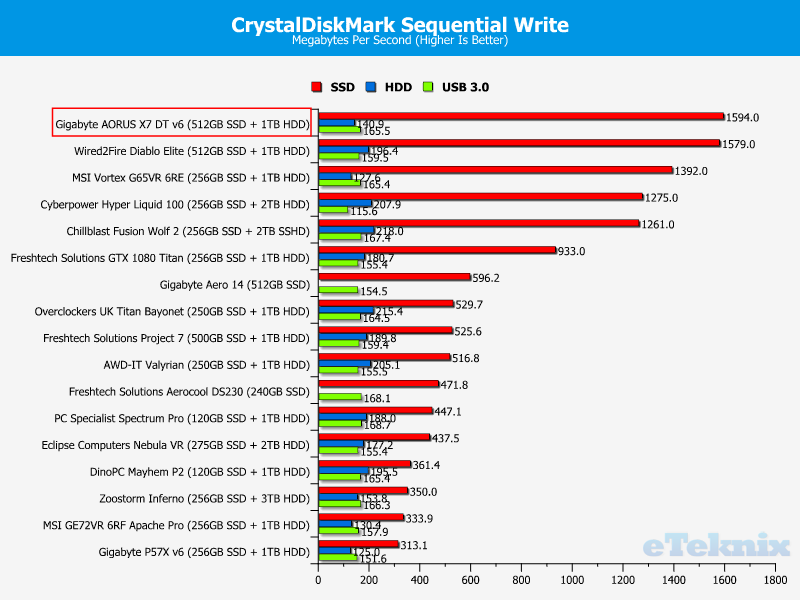
Networking Performance
Passmark PerformanceTest 8.0
Ethernet (LAN)
AORUS opted for the Killer E2200 networking solution which upholds consistently high bandwidth numbers within a small range.
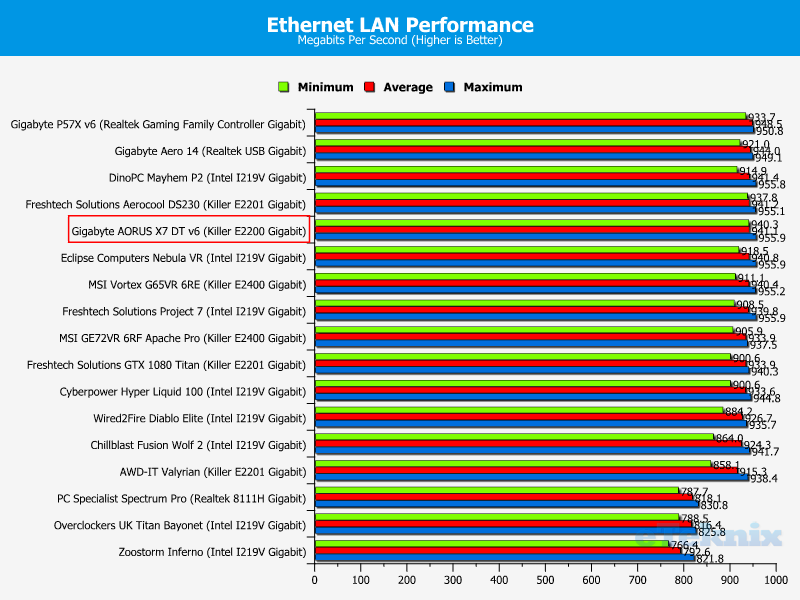
WiFi
The laptop’s WiFi performance was exceptional and the minimum recorded figure easily eclipsed previously tested systems.
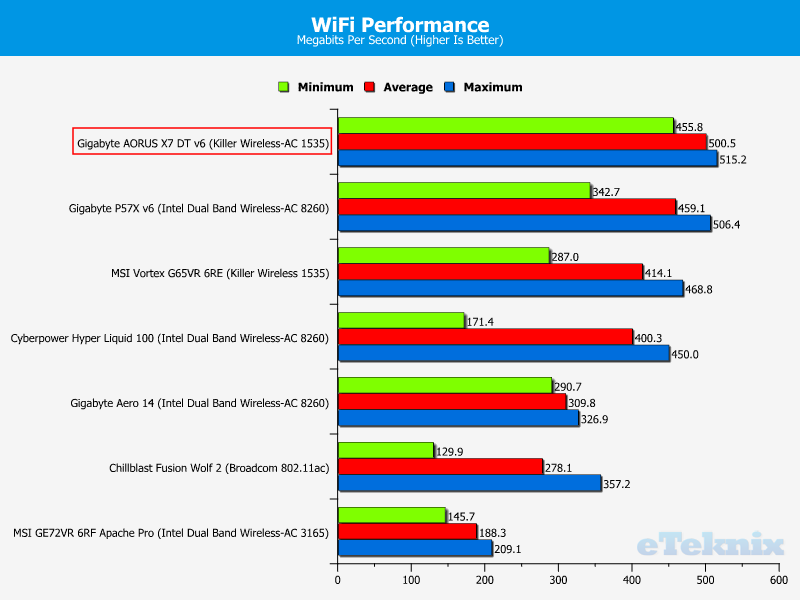
Acoustic, Battery, Power & Thermal Performance
Acoustic Performance
During idle conditions, the AORUS X7 DT v6 is really quiet and I couldn’t detect any fan noise. It’s practically silent and makes the laptop a joy to use. Unfortunately, the noise output increases at a blistering pace under stress even when using the normal fan profile. The noise levels are difficult to adjust to unless you’re wearing a pair of noise-isolation headphones. Even though the noise output isn’t a shock due to the thin frame, I would have preferred a result under 50 dBA.
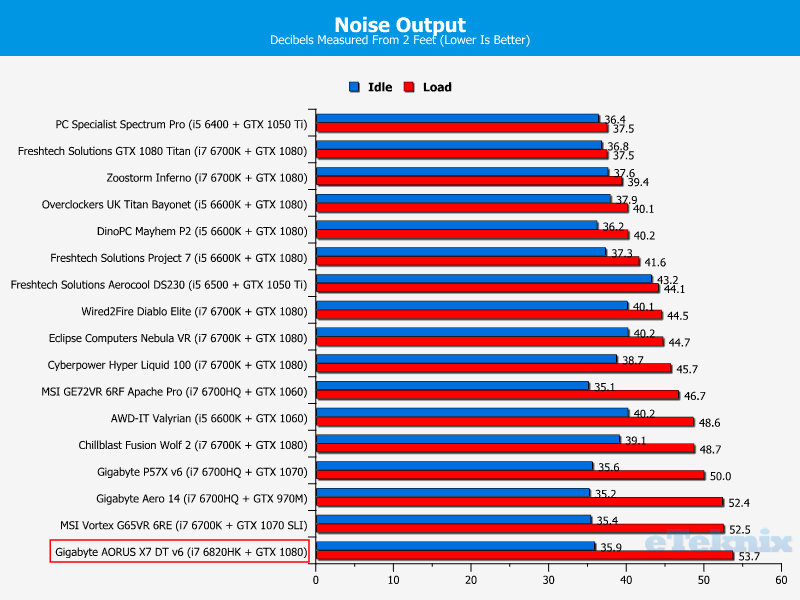
Battery Life
Despite incorporating a huge battery, the running time isn’t great and the laptop barely managed to pass the two and a half hour mark. I can’t pinpoint an exact reason why and it’s important to remember that NVIDIA’s G-Sync technology doesn’t impact on battery life.
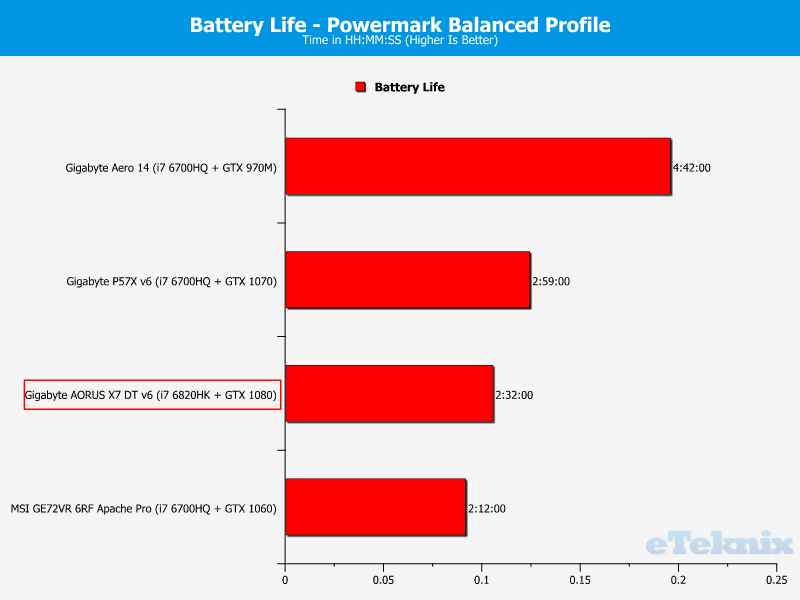
Power Consumption
When idling, the laptop is really efficient and consumes a mere 37-40 watts. During games and other demanding tasks, the wattage peaks at 270.3 before settling back to a 254.9 average.
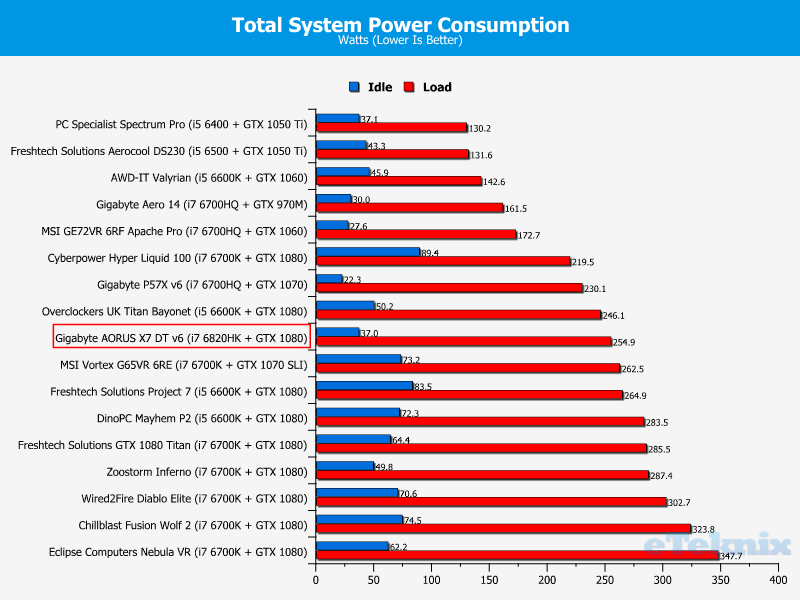
Thermal Performance
In a disappointing turn of events, the laptop’s cooling solution cannot maintain the CPU’s 4.0GHz frequency during the AIDA64 stress test. The CPU begins to heat up really quickly and it doesn’t take too long before the frequency is scaled back to prevent hardware failure. According to HWMonitor, the 4.0GHz clock leads to a 100C maximum value before changing the frequency to 3.6GHz. Once this occurs, the temperatures begin to recover to more acceptable levels and the CPU dynamically adjusts the frequency upwards to 3.8GHz. Clearly, the 4.0GHz figure is not sustainable and I’d recommend either using the processor’s stock configuration or an overclock which requires less voltage.On a more positive note, the GPU thermals were excellent and easily within the chip’s maximum operating window.
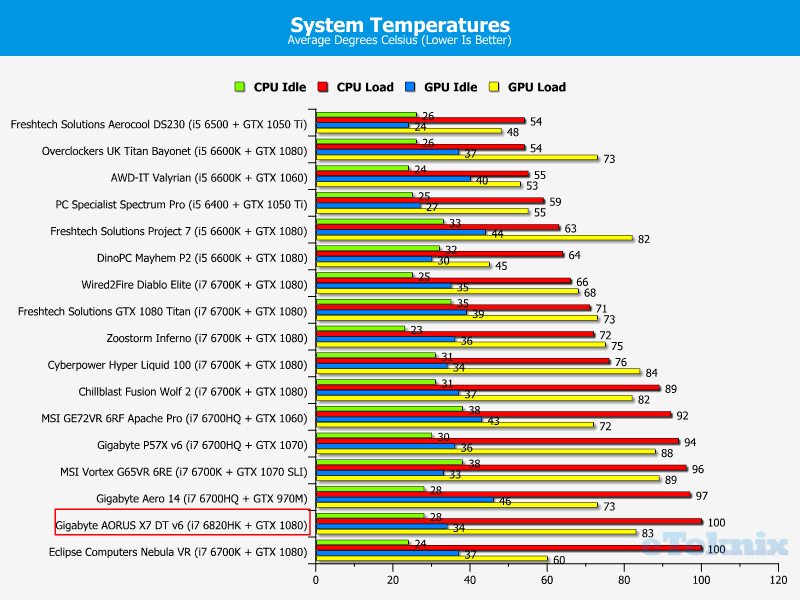
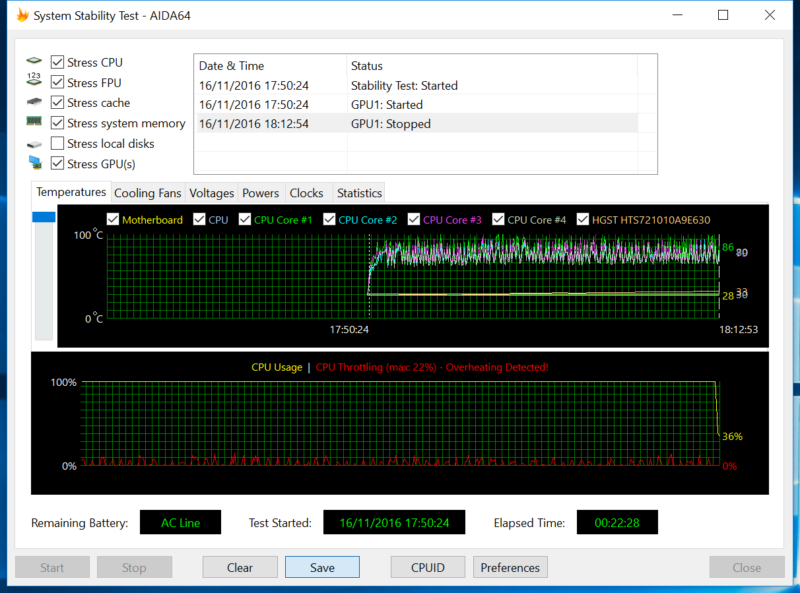
Final Thoughts
Pricing
Currently, the AORUS X7 DT v6 utilising the GTX 1080 is available from Overclockers UK for £2999.99 and Scan Computers for £2999.99. If this seems out of your price range, it’s possible to acquire the GTX 1070 version for £2483.99. Clearly, this is a massive sum of money and the only way to fairly judge value involves comparisons with similar products. Unfortunately, I couldn’t find an identical configuration which complicates the process somewhat. One alternative is the MSI GT73 VR which retails for £2699.99 and has 32GB RAM, an Intel Core i7 6820HK and the GTX 1080. However, the screen is only 1920×1080 and doesn’t support G-Sync. Also, the memory runs at a slower speed although the RAID0 NVMe array might be a selling point to some.
The only other option is the MSI GT73 VR 4K GTX 1070 SLI edition which costs the same as AORUS’ creation. Interestingly, this product has a 4K IPS panel, dual GTX 1070s, 32GB RAM and an Intel Core i7 6820HK. Once again, the panel doesn’t appear to support G-Sync and you’re trusting developers to implement SLI scaling to outperform the GTX 1080. After assessing the competing options, I’d argue that the laptop is priced fairly and has a unique place in the current market. This makes it a great choice for someone with £3000 to spend on a desktop replacement.
Overview
The AORUS X7 DT v6 sports a really distinctive, elegant design which exudes a premium feel. In particular, the neutral charcoal finish is splendid and combines rather nicely with the silver AORUS logo. The product’s remarkably slim frame is surprising when you consider the mammoth horsepower at your disposal. While the laptop isn’t the most portable option available today, it’s lighter than competing models opting for a similar form factor. For example, the MSI GT73VR weighs 3.9Kg while the AORUS X7 DT v6 is 3.2KG. Judging a product’s visual appeal is difficult because it depends on subjective taste. Saying that, I personally believe that the AORUS X7 DT v6 is one of the most attractive laptops ever devised.
AORUS incorporated a 17.3-inch 2560×1440 120Hz WVA panel which supports NVIDIA’s G-Sync technology. The high refresh rate is a wonderful asset which makes cursor movements in Windows feel more responsive and allows for smoother motion when playing video games. On another note, NVIDIA’s G-Sync technology is fantastic and removes stutter as well as ugly screen tearing. This contributes towards a much more enjoyable and consistent user experience. The laptop’s panel has a stunning colour reproduction and good contrast ratio. Although, the viewing angles could be improved ever so slightly.
The laptop’s audio solution is surprisingly decent and able to deliver high volumes without distortion. Furthermore, the sound isn’t tinny or lifeless and has a good amount of bass despite the thin frame. Of course, it’s not going to compete with a pair of headphones, but the sound was much better than I expected. Connectivity-wise, the AORUS X7 DT v6 supports numerous interfaces including USB 3.1 Type-C, USB 3.0, HDMI 2.0 and Mini-DisplayPort. The only omission is Thunderbolt 3 which would have added a great upgrade path due to the advent of Thunderbolt 3 GPU enclosures.
AORUS also made significant strides forward with the keyboard which now supports RGB backlighting. As previously mentioned, the colours are gorgeous and add a spectacular twist to the laptop’s subtle design. Also, the keys feel responsive and the chiclet layout helps to position your fingers in a more proficient way. The macro keys are easy to reach without stretching and come in handy when playing MMOs or MOBAs. The laptop’s touchpad has a soft finish and large area which leads to a higher level of accuracy.
Successfully taming the laptop’s CPU while maintaining a slim profile was always going to be an uphill task. Upon inspecting the cooling hardware, I was impressed with the heat pipes thickness and logical arrangement. Unfortunately, this wasn’t enough to cope with the default 4.0GHz frequency. Subsequently, the processor downclocks to 3.8GHz and below due to thermal restrictions. Not only that, the noise output is huge and this even occurs when utilising the modest fan speed settings. It’s not a shocking revelation, but the noise output will be irksome to many people. Thankfully, the idle noise output is much better and almost silent.
On a more positive note, the Samsung SM951 NVMe boot drive offers exceptional performance which makes traditional SATA devices look painfully slow. The end result is faster rendering times and Windows reacts your commands instantly. The laptop’s WiFi and wired results were exceptional and didn’t exhibit any sudden packet loss or large speed drops. I wasn’t too pleased with the battery life though and expected more given the amount of space it takes up.
NVIDIA’s Pascal architecture completely destroys the previous generation chips and make gaming laptops a more sensible investment. The AORUS X7 DT v6’s GTX 1080 easily copes with demanding graphical settings and can even drive an external 4K display while achieving playable frame rates. Throughout the review, the laptop’s graphics card matched a number of premium desktops. Amazingly, the GPU offers a glorious user experience and complements the 120Hz panel rather well. The embedded GPU doesn’t encounter stutter or erratic dips. Honestly, it’s astounding to think this much performance can be crammed into such a thin laptop.
Pros
- 120Hz 2560×1440 G-Sync panel
- Attractive per key RGB backlighting
- Comfortable keyboard
- Elegant design
- Fantastic networking performance
- Great software package
- Luxurious packaging
- Remarkably thin frame for the horsepower on offer
- Stellar build quality
- USB 3.1 Type-C
- Wonderful storage read/write speeds
- Vibrant sounding audio system
Cons
- Extremely loud under load
- Mediocre battery life
- Runs hot when the CPU hovers between 3.8-4.0GHz
“The Gigabyte AORUS X7 DT v6 offers a premium gaming experience which rivals traditional desktops. While the noise output could be better, the product’s gorgeous slim frame, astonishing build quality and responsive 120Hz display should be an attractive proposition for users wanting the absolute best performance in a relatively portable form factor.”

Gigabyte AORUS X7 DT v6 GTX 1080 Gaming Laptop Review
Thank you Gigabyte for providing us with this sample.



















